Weekend Immendorff SNOW DOME ARCHIVE 2020 list of contents here
Exhibition Statement here
Erika Scott Interview with David M. Thomas about works for exhibition at stable
15 August 2020 (Funhauser Studio, Wynnum)
Erika Scott: Your new-found love of wool and weaving is exciting. There’s so much to look at but also through. Like your collages there seems to be this reliance on outlines and block colouring, a phasing out of detail. These gaps and hollows between the strings and shapes make me think of guitar strings but also zooming in on clothing, couches and old school speakers, probably because you’ve also worked directly onto old school speakers and play the guitar. Is this ‘floating’ and heightened permeability of your weaving for this show a response to the room divider? Or are there other motivations at play?
David M Thomas: That’s a big question (laughing), but what I want to do if it’s ok is use that question as the written introduction for the show?
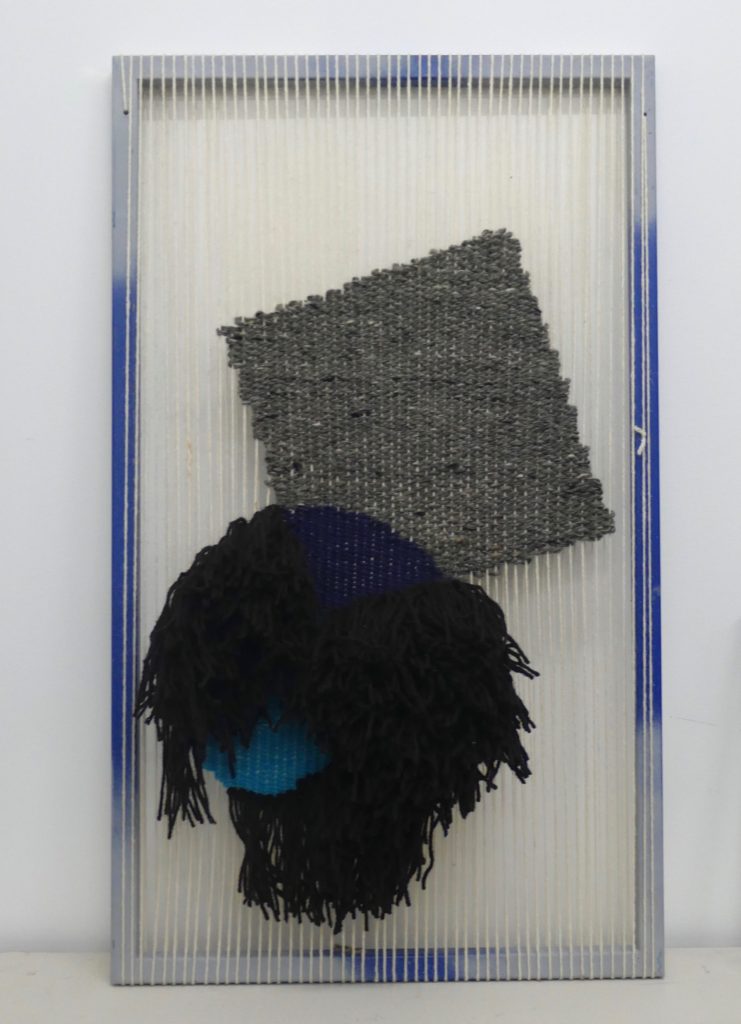
E: Ok…yeah… of course I just wrote this and a lot of them if anything are just me repeating myself in different ways.
D yes like you said there are five different questions in there.
E Yeah
D in-terms of the formal blocking out and the reduction of information and all that, in regard to shapes, I have been teaching in a painting environment for the last two and half years I have been interested in the story of modernist abstraction, the story that is told through the development of modernist painting. At the same time I had a post-modern education. But I was looking at some of those processes through just those movements I was interested in such as Dada but particularly Arp, Arp’s work in relation to playfully swinging between the existing disciplines.
E Yeah
D between collage, sculpture and painting in one work, So it’s a very difficult to consider in relation to one formal thing… so yeah it was again engaging with that history that…
E So that was more after you were teaching or has that always been there?
D Yeah I think it’s always been there but it has intensified because I am always trying to write a lecture or a course outline or something to do in the studio to activate or demonstrate an idea.
E Yep
D And I think with what’s happened with the lockdown and pandemic period, with the restriction of movement, has given me the opportunity to spend more time in the studio and work more intensely, to just deal with working through a little projects, like these collages….(D wonders around studio looking for a folder of collages)
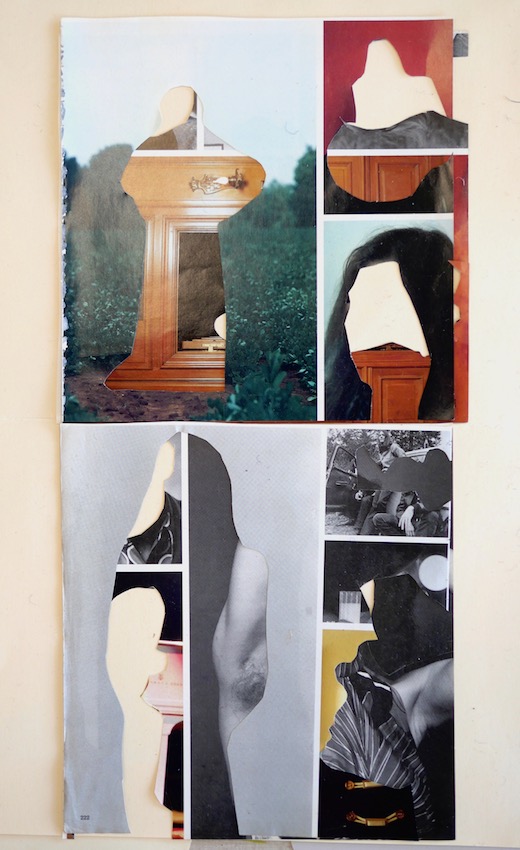
E So when you are doing these 2D collages, it’s also about sculpture and objects…it’s about every thing like you said, you are not just doing one thing?
D I am certainly aware of relationships of… and also all this art historical detritus…. so I was going through my book collection and I have had this book in my collection since I was very young person. (D presents a half disassembled 20 year anniversary edition of Rolling Stone magazine)
E is that what you collage out of? Is it too precious?
D that is a 20 year anniversary edition of Rolling Stone Magazine, and what it documents is a position of the then somewhat radicalised left as it is simultaneously being commercialised and co-opted. And that’s the other part of that history, there’s the art history part and there’s the social political history part.
E So this is one mag right?
D It’s a compilation and yeah it’s a music magazine but because the music and the popular culture were so politicised at the time it’s also like a political commentary going on at the same time.
E Oh yeah so there no pictures?
D well I took all the picture out because it was falling apart… and I thought
E Laughing… there’s some good ones
D The things I was drawn to the most were like these “Years” that’s what these are at the bottom little tags like “Faces” so what I started doing was cutting those faces out, thats the normal place where you would start if you were to do a fanzine style collage, you take all the celebrity faces and that’s the bit that you would use.
E That’s the labour of love…cutting them all out…
D Yeah adoration and acknowledgement
E Yep
D and so what I was noticing that what was interesting to look at were the voids and the empty spaces, and what that does superficially is it abstracts the outline and silhouette. But it’s a removal of the celebrity or the star or the politician.
E It’s more like the frame work rather than the style or…
D it’s the space that they are in, it’s the time they’re in, it’s where they are you know? and what is left is like a resonant form, which I didn’t really think about that until a later one, where I opened it up completely where I wanted it to be much more about those (resonant forms)
E Is that a manila folder
D yep they are all on manila folders
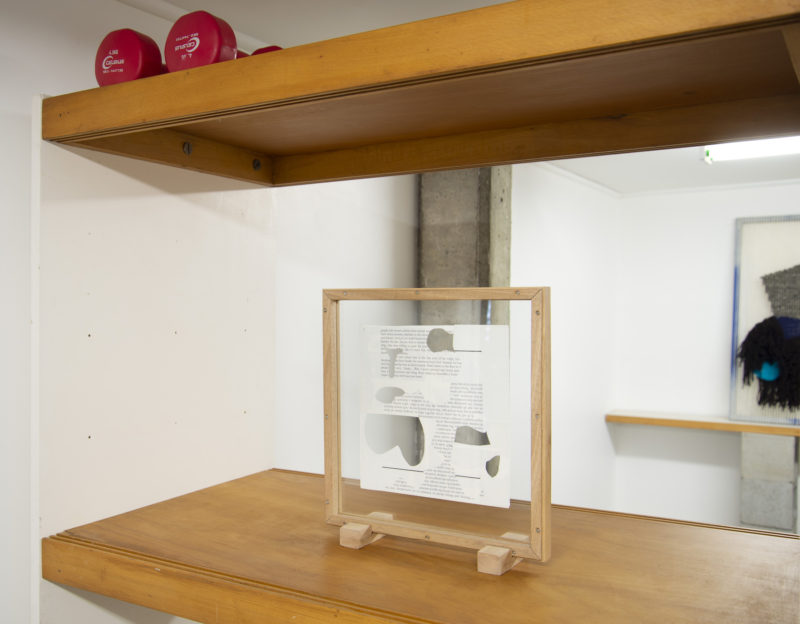
E Will they be in the show?
D mmmmmmm I haven’t really decided what is and what isn’t in the show… I have thought that in some way they would. But maybe one.
E Yep
D there are some that are quite painterly and there are some that are more sculptural, because its just about drawing your attention to an action.
E There are some funny body movements
D yeah is that a guitar or is it..,what’s that you know?
Laughing, there are things that you can’t control which I quite like
D Then theres this one
E Yeah I like that one that you had as the image
D this one is cumbersome….. because I have to mount it between two pieces of glass with clips
E Nice
D what I really want to do is have it between two pieces of glass and on some sort of a stand so you can see both sides.
E a little mic stand or something?
D Mic stand?
(Laughing)
D But yeah that’s right (pointing at one of the cut out weavings) that ones on a guitar stand.
E mmmmm yeah that’s just what I imagined, oh yeah so there are two sides now I get it.
D yeah both sides are good, sometimes that’s the way, both sides are really interesting
E I had a question about the timber forms, but I feel like you may described it better when you were talking about these, are they related? The timber forms with the kind shapes from the magazines?
D Well the process is directly related…. obviously the egg shape, that comes from our group is an identification with that group, like these other shapes (D grabs one of the MDF cut out shapes) these other shapes come from actions, like a figure 8 painting action. And also you remember how you pointed out that thing that Suzanne (Howard), Joseph (Breikers) and I did at Metro Arts, where we did the cut outs? the way we got those cut out shapes and an initial inspiration was (Hans)Arp for that and but it go filtered through Jospeh’s practice of creating a doodle and then a shape around the doodle… you know?
E Yeah yeah I get ya
D I thought that was a fantastic idea, so I continued that Idea a little bit, but also extended it.
E I had question because when I read the thing you wrote about, it’s easy to make counter positions, I am trying to think of the actual sentence you said. I talked about these things being like kinda loose cartoonish gestures and loops, and the flat paint folds and disappears into itself and the pine cutouts overlap and lean so it’s like the physical 2&3dimensions are folded. Is it heavy handed to read that as an exercise in these counterpositions? or initiating more streamlined definitions of identity and perspective? Hang on that’s pretty whack hang on, you had to read what I wrote before that.
You said “I like the word room divider, for me it conjures up what most people mistake for ideology, rather than a set of ideas shared by a group, the expression room divider evokes an opinion that divides a room. It’s always easier to come up with a counter position on a topic than to research, think and develop a system of thought.” so I was thinking these shapes are something like streamlining things with more options perspectives? too whack?
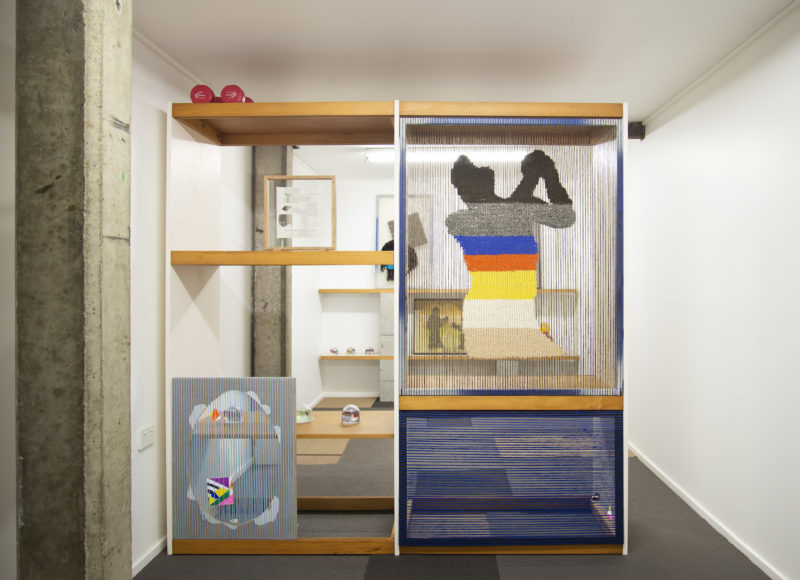
D No it’s not too whack but what would be far whacker and more idealistic would be to say that the formal political imperative of what I am doing is to draw people back to the act of looking at something. dealing with what it is, what the person was doing when they made it, things they were looking at, and at the same time believing that if we were to deal with the world more based on what we see….. (rather than what we are told about it)
But I am open to the possibility that you can come up with a new way of thinking about it… That story of modernism has a certain comfort in it it gives you something to do, but yes I will have to think about that question a bit more.
E I have another one, if the first one wasn’t enough, this one is another paragraph, you mentioned that you feel the room divider represents your unfulfilled contribution to what you felt that Suzanne and your mother worked towards and cared about, and how you and Suzanne collaboratively worked toward the design of your current dwelling and then shaping that environment and coastal setting as a beach house. and I know that your mother wove at one stage of her life and she used wool and I am assuming that they were like found materials because that is what my Grandma used to do…
D ..my mother would go to industrial fabric suppliers wool suppliers buy raw stuff, and she would in fact spin she had a spinning wheel, she was very serious about the materials and has was looking at them as if they were fine art materials.
E yeah yep, I just remember that you showed me, did she do the mens ties?
D No that was my sister Barbara she was in that show at Knulp as well.
E Oh ok your sister was into that as well?
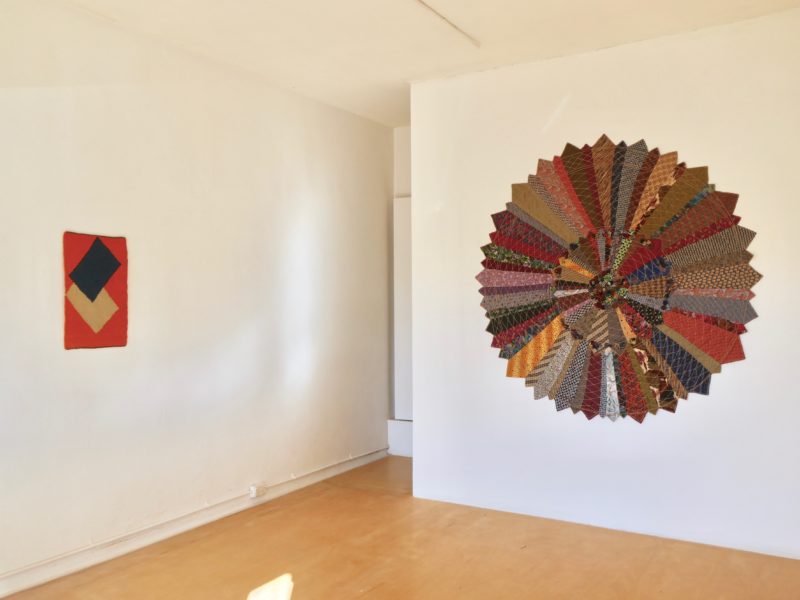
D She has that attitude, (but didn’t go to art school) maybe because I lived with here when I went art school, and we were very close and she would come to CBD (gallery) and helped out, there is no way you can be involved as a participant and not have ideas seep into you,
E thinking about all those woman this might be the wrong word but I suppose the respect for the material but also the modifying and responding to the material is part of your process and design sense potentially even a shared design sense with Suzanne? or is it about like …..how ideologies of design streamline with our relationships and identities?
D I think about the development of a sensibility a lot, I think that incorporates taste, intellect and a conscious negation of those things and resistances like we were just talking about. And Yes Suzanne and I had a shared practice, my mother and I had a shared practice the first time I made things, and I could probably show those things now in the context of this show if I wanted to, if I had them, I was about 10, so first time I made things was along side my mother, she was always an enthusiastic educator and she made it look like a nice life. There was always people around it was a good sign.
Another thing I talked about in those notes is the relationship between Terrence Conran and Elizabeth David what they were known for is what became know as a life style. An I have replaced that word with the word sensibility because life style has become so ubiquitous with Instagram and influences and things like this…
E So it’s like being active in you space rather than passive?
D Actively engaging with the forms and ideas
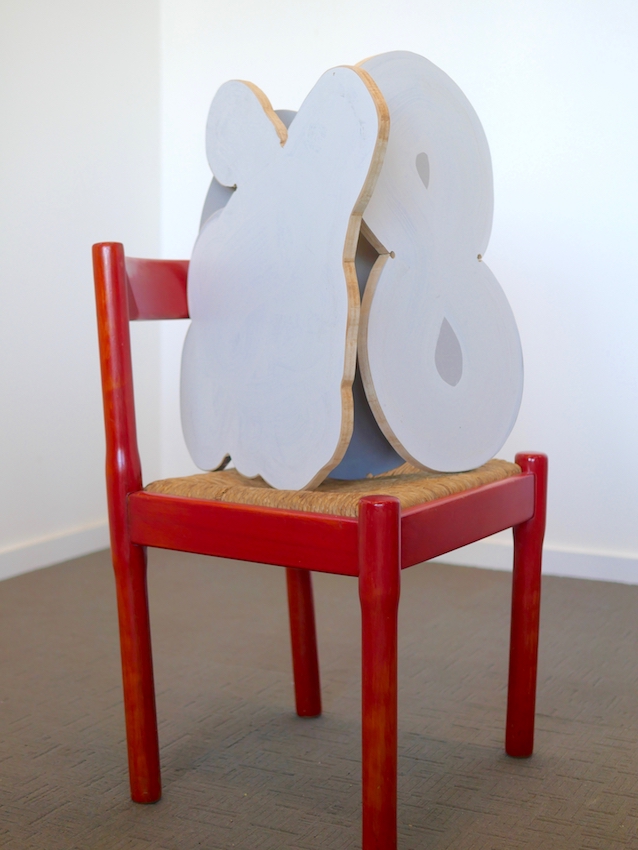
E so where does art sit in the life style? is being critical of the life style or just a part of the life style? are the objects
just a part of it?
D we are actively engaging with the forms and ideas,
another thing I used to say to Suzanne we’d have these discussion about being sucked into the vortex of politicised social media, was that she was being used by that system, you might feel like you are being active, but you are actually just keeping the wheels going of their algorithm and that you should take that energy and apply it to your own realm? There is something and I am not going to say “against God” about social media, but there’s something… you feel when you are being sucked into it and you can feel that too much of it is not right.
E Yep
D But conversely the feeling you get when you are active and you are doing things in the studio, you feel connected to things, you have a positive feeling, that may seem strange but you have had that feeling, you feel physically connected to things and that’s probably why I am attracted to those materials they feel like something they have a sense of what they are and they have a history and a life of their own and attempting to participate with that.
E because you were talking about that carer love and then how you said objects are like living vessels without biological life but more in a phenomenological, biographical… and when cared for they out live there custodians
D yeah I’m not really sure about that, I was loosely paraphrasing object orientated ontology that I have given some attention to
E yeah because I suppose that there are some things we care about that don’t get passed on don’t get the traction they should
D or don’t get looked after, those ideas are really part of that, but I am trying not to emphasise the sadness in these works. But that is very true some things are not looked after.
long pause
E I had this other thought but I think its more about my own work though.. I feel like I am putting all this stuff together these things make sense and there are all these connections and relationships and things. But when that’s translated outside of me people go to talking about it in relationship to disruption or collage and that what made me think about your counter positions because its like it could be different kind of thought but people just experience it as a counter position, or do you feel like your materials are butting up against each other or do they feel more fluid like a language or something like that.
D I think it’s becoming more fluid, not really like a language so much but… the connections are becoming a bit more apparent maybe?
There’s a very trite William S Burroughs quote where he says “when you slice into the present the future leeks out ”because he was very interested in collage as a process for writing which of course becomes a very different thing and he was also interested in magic and stuff like this. But if you look at it from Heidegger’s point he might say, if you are in tune with your project and you develop a sensibility and set of tools that are in line with the history, you know these things that I am using, I am not selecting anything, I am going to something that already represents a political and social history if it’s art history or music history or political, I am aligning myself with these things but they are are already connected and I am connected to it, and thats what I am considering, I’m considering those relationships formally…
E but you are squeezing all that personal stuff in there as well
D yeah and I am not really 100% sure what the value of that is, whenever I do something that has autobiographical content that talks about where the work is coming from personally I feel like I am buying into that thing where people are more comfortable talking about the artist than the art work, plus the line, “just because it happened to you doesn’t make it interesting”. But the counter position in my head when I think that is what is happening to me is pretty fucking interesting at least to me.
E I think it is interesting but also it’s the landscape anyway, the history is an image and that can be used as a formal thing as well..?
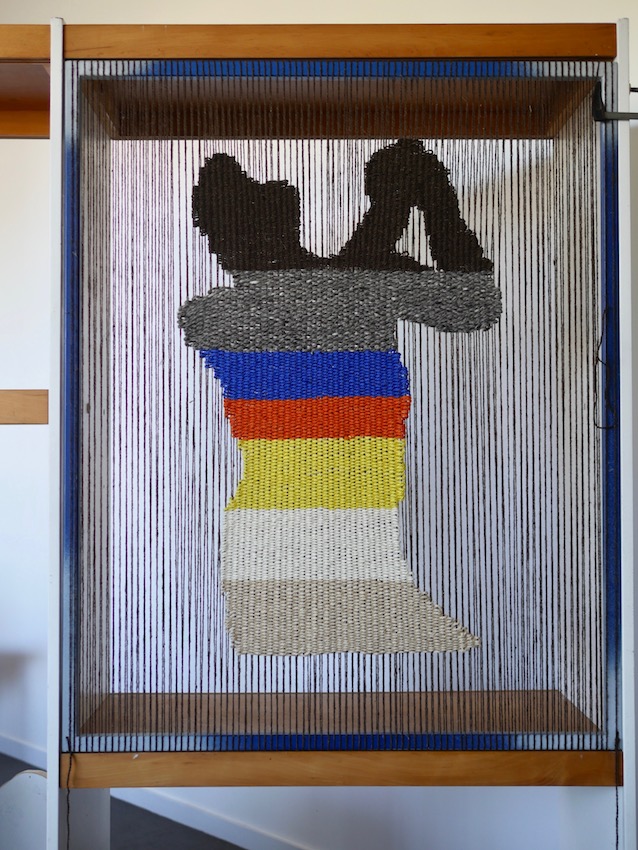
D (pointing to a woven outline of Iggy Pop) I loved that you felt that that figure was Suzanne, that’s lovely because obviously when I am making these works and working in this space and I am working with these materials I am thinking about her I am hearing her, to certain extent yeah she is still there.
E When we talk about things I am always collecting and you are always down sizing so it’s the ongoing conversation we have?
D Well Im 20 years older than you
E Laughing, I was just wondering if anything has changed since this house was completed? and do these processes of caring and making art get any easier or harder if there is a relationship between this house and accumulating things and objects?
D Yeah there is because the more space you have the more stuff you can accumulate, the most significant thing that happened since was that Suzanne passed away, and the person that was central to the place and to my life disappeared all of a sudden, in her physical presence and she had a remarkable physical presence. does it get easier? somethings get easier and somethings harder. Somethings about making work, I think get easier, you recognise what is good in what you do and what you don’t want to do, but it gets harder to continue sometimes, but I think that is hard for anyone, under the circumstances anybody doing anything is quite miraculous.
E Yep I was thinking that too with everything
D I think the act of continuing is a theme that is in Kippenberger’s practice and it’s ironic because his ‘gung hoh’ ‘never give up’ attitude was minus a certain self preserving reflectivity, enough atleast to keep him alive, I mean he died when he was 46.